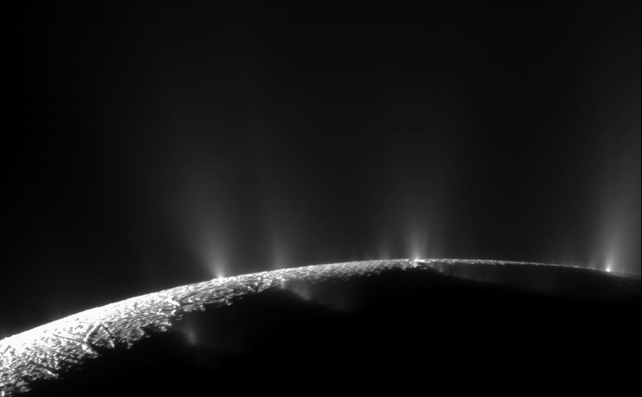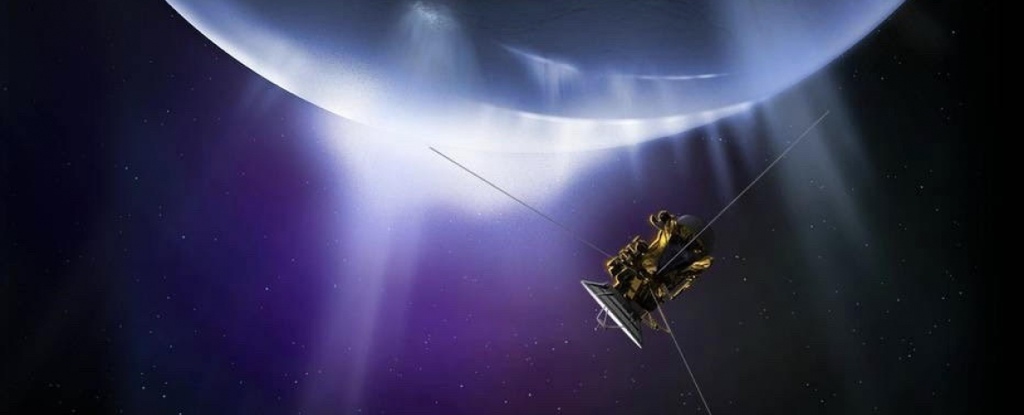Saturn’s moon Enceladus is one of the Solar System’s prime extraterrestrial locations for life to thrive. It harbors a global salty ocean that internal heating theoretically keeps at temperatures hospitable to an alien marine ecosystem.
Detecting that life, however, is not such an easy matter. The moon is enclosed by a shell of ice that’s estimated to be 5 kilometers thick (3.1 miles) at its thinnest point, and the ocean below it is 10 kilometers deep. This would pose a huge enough challenge here on Earth, never mind a moon half a Solar System away.
But we may not need to go to all the effort of drilling through Enceladus’s shell after all. A new study finds that we ought to be able to detect life on the icy moon in the plumes of salty water that erupt from its surface – even if there’s not all that much life there.

“Clearly, sending a robot crawling through ice cracks and deep-diving down to the seafloor would not be easy,” says evolutionary biologist Regis Ferrière of the University of Arizona.
“By simulating the data that a more prepared and advanced orbiting spacecraft would gather from just the plumes alone, our team has now shown that this approach would be enough to confidently determine whether or not there is life within Enceladus’ ocean without actually having to probe the depths of the moon. This is a thrilling perspective.”
Enceladus is very different from Earth; it’s hardly likely to be crawling with cows and butterflies. But deep under Earth’s ocean, far from the life-giving light of the Sun, a different kind of ecosystem emerged. Clustered around vents in the ocean floor that spew forth heat and chemicals, life relies not on photosynthesis but on harnessing the energy of chemical reactions.
What we know of Enceladus suggests that similar ecosystems might be lurking on its seafloor. It completes an orbit of Saturn every 32.9 hours, traveling on an elliptical path that flexes the moon‘s interior, generating enough heat to keep the water closest to the core liquid.
This isn’t just theory: At the south pole, where the ice shell is thinnest, giant plumes of water hundreds of kilometers high have been seen erupting out from below the ice, spewing forth water that scientists think helps contribute to the ice in Saturn’s rings.
When Saturn probe Cassini flew through these plumes over a decade ago, it detected several curious molecules – including high concentrations of a collection associated with Earth’s hydrothermal vents: methane and lesser amounts of dihydrogen and carbon dioxide. These can be linked to methane-producing archaea here on Earth.
“On our planet, hydrothermal vents teem with life, big and small, in spite of darkness and insane pressure,” Ferrière said. “The simplest living creatures there are microbes called methanogens that power themselves even in the absence of sunlight.”
Methanogens metabolize dihydrogen and carbon dioxide, releasing methane as a by-product. Ferrière and his colleagues modeled the methanogen biomass we might expect to find on Enceladus if the biomass existed around hydrothermal vents like those found on Earth.
They then modeled the likelihood that cells and other biological molecules would be ejected through the vents and how much of these materials we would be likely to find.
“We were surprised to find that the hypothetical abundance of cells would only amount to the biomass of one single whale in Enceladus’ global ocean,” says evolutionary biologist Antonin Affholder, now of the University of Arizona, but who was at Paris Sciences et Lettres University in France at the time of the research.
“Enceladus’ biosphere may be very sparse. And yet our models indicate that it would be productive enough to feed the plumes with just enough organic molecules or cells to be picked up by instruments onboard a future spacecraft.”
Equipped with the expected abundances of these compounds, an orbiting spacecraft might be able to detect them – if it could make multiple plume flythroughs to collect sufficient material.
Even then, there might not be enough biological material, and the chance that a cell might survive the trip through the ice and being spewed out into space is probably pretty slim.
In the absence of such a smoking gun, the team suggests that amino acids such as glycine would serve as an alternative, indirect signature if abundances exceed a certain threshold.
“Considering that according to the calculations, any life present on Enceladus would be extremely sparse, there still is a good chance that we’ll never find enough organic molecules in the plumes to unambiguously conclude that it is there,” Ferrière says.
“So, rather than focusing on the question of how much is enough to prove that life is there, we asked, ‘What is the maximum amount of organic material that could be present in the absence of life?'”
These figures, the researchers say, could help design future missions in the years to come. Meanwhile, we’ll just be here on Earth, wondering what an ecosystem deep under the ocean on a moon orbiting Saturn might look like.
The team’s research has been published in The Planetary Science Journal.
